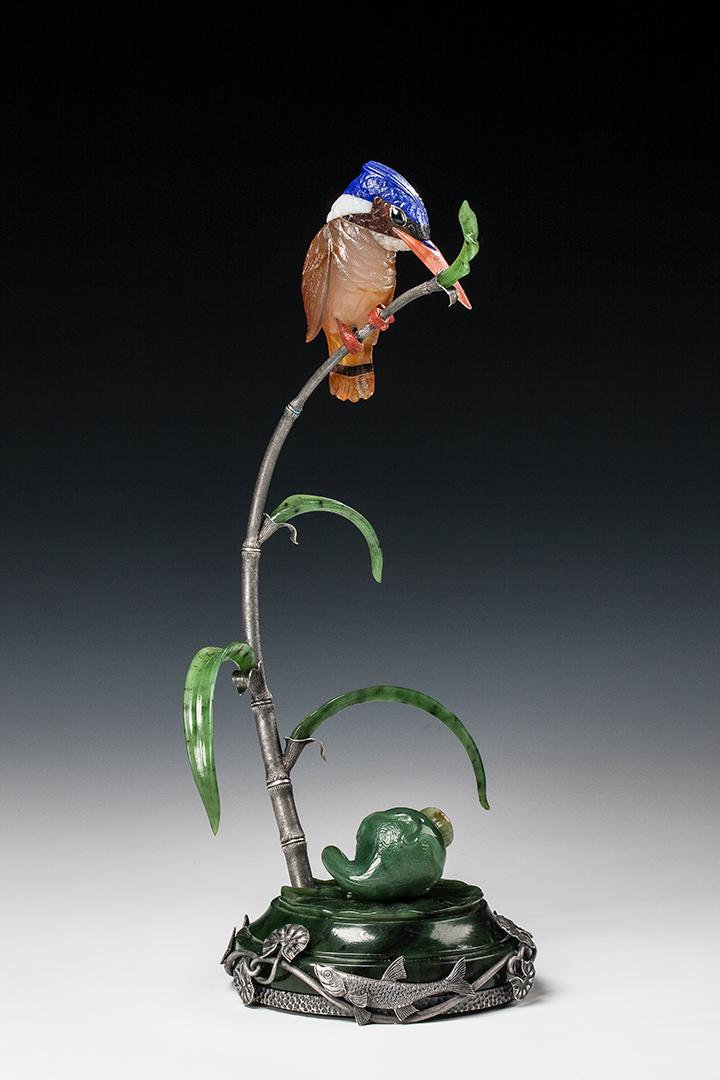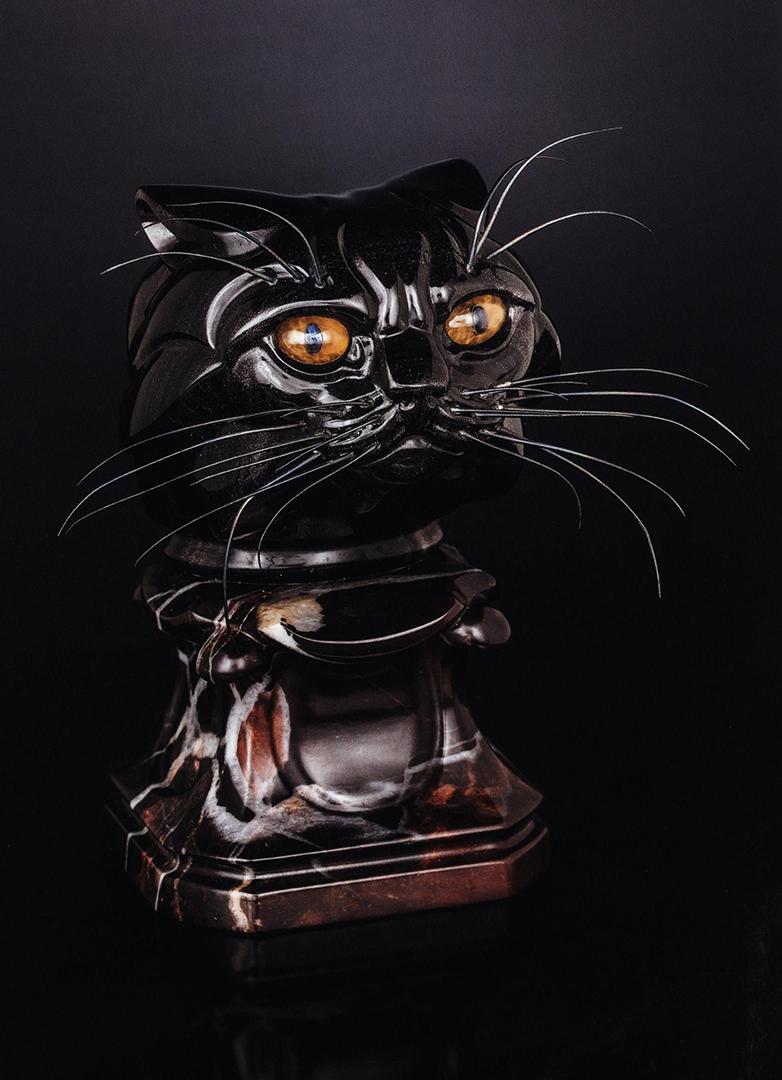Fabergé: Contemporary Gemstone Carvin
 омпозиция «Полевой букет» ООО АННА НОВА 2009 Золото, серебро, драгоценные камни, кахолонг, нефрит, аметист, кварц Высота: 35,4 см ©Государственный Эрмитаж - Mit freundlicher Genehmigung von: hermitagemuseum
омпозиция «Полевой букет» ООО АННА НОВА 2009 Золото, серебро, драгоценные камни, кахолонг, нефрит, аметист, кварц Высота: 35,4 см ©Государственный Эрмитаж - Mit freundlicher Genehmigung von: hermitagemuseumWas: Ausstellung
Wann: 09.07.2022 - 31.12.2023
Wo: St Petersburg, Russland
The display tells about the creative endeavours of modern-day artists, their experiments in working with semiprecious stones and their striving to combine the achievements of their predecessors with fresh tendencies. The exhibition features more than 35 works that bring together original ideas and a subtle feel for the material, professional execution and virtuoso technical approaches. The creators of the majority of the works are gemstone-carvers based in Saint Petersburg. Also on show in the hall are pieces made by present-day German craftspeople, representatives of the oldest school of European gemstone-carving art located in the town of Idar-Oberstein.
The art of stone-carving has a history going back many centuries in Russia. The time of Peter the Great’s reforms was an important moment for the formation and development of this field of creativity in the country. In the 19th century, interest in this art form declined, but around the turn of the 20th century it underwent a revival thanks to the success of the articles produced by Carl Fabergé’s firm, which included figurines carved from semiprecious stones. It was the craftspeople of the celebrated jeweller’s firm in particular who established the main tendencies and genres in the field of gemstone-carving that are still being developed by artists in Saint Petersburg today. The official starting point for the revival of the city’s school of gemstone-carving is customarily taken to be 1989, when the creative group Plastika v kamne (Plastic Art in Stone) was established. The early 2000s saw the appearance of such jewellers’ workshops as The School of Stone-Carving Art, Bagulnik, The Stone Guest, the TerraFaberus creative union and Anna Nova.
One of the most popular genres among present-day gemstone sculptors is the depiction of animals. Portrayals of snakes, frogs, toads and snails hold a particular attraction for the artists. Philosophical meanings and mythological allusions abound in the compositionally dynamic works of Anton Ananyev (The Snail of Babylon; Praying Mantis) and Alexander Veselovsky (Scorpions). A love of the animal world and an admiration of nature are vividly reflected in the works of Sergei Stankevich (Tortoise) and Slava Tulupova (Fish; Frog). The works of Sergei Falkin (“Wave” snail and “Gothic” snail) are marked by an emphatic minimalism, a rejection of detailing. Artists may introduce elements of stylization or the grotesque, experiment with the treatment of the surface or with form and line, as can be seen in the works of Vladimir Putrin (Dance) and Irina Ostanina (Panda). Among the depictions of animals in the manner of Fabergé mention can be made of Vladimir Iliukhin’s Baby Mouse and the creations of the German gemstone-carvers Gerd and Patrick Dreher (Frog; Snail).
Fabergé’s “bouquets” continue to inspire present-day exponents to create gemstone compositions in the floristic genre. The main things that the modern artists seek to acquire from their predecessors who worked for the legendary firm are a knowledge of the complex technology and nuances jeweller’s craft, the high art of modelling and the formation of a palette of different coloured stones. This is true, for example, of the Wildflower Bouquet created in the Anna Nova workshop. At the same time, Petersburg gemstone-carvers are rethinking the style, shifting the emphasis from naturalism to the compositional arrangement and sculptural expressiveness. The composition La Fleur du Mal by Anton Ananyev has a title that alludes to Charles Baudelaire’s well-known poetry anthology. It is striking for its philosophical breadth and the perfection in the working of the details and the surface. A sense of dynamism fills the stylized depiction of a bloom ( Northern Tulip) from the Anna Nova workshop. Sergei Shimansky’s amber Maple is amazing for its sculptural qualities and fine execution. Yaroslav Ksenofont and Mikhail Komarov combine animal and floral elements in their work Bird.
Gemstone-carvers have conducted some bold experiments in the genre of polychrome blocked sculpture. The creation of such works, composed from several different types of mineral, requires a high level of craftsmanship and fine artistic taste. Works of this kind include The Cat Behemoth and the fantastic creature Tengo, both by Gennady Pylin. Other striking examples are the compositions Time by Sergei Shimansky and Temple by Alexander Levental and Olga Poptsova.
An important role in the creation of gemstone sculptures is played by the properties of the material itself: density, lamination, absorption of light, luminescence. In their works, modern-day artists reveal the possibilities of forms and bring out the natural beauty of semiprecious minerals.
Yevgeny Morozov spotted the cap of a mushroom in a piece of moss agate and managed to make great play of that material in his legendary creation Mushroom (walking stick handle). By working with a translucent mineral such as quartz, employing the contrast between matte and polished surfaces, achieving the most effective refraction of light or giving the surface expressive facets, an artist can produce striking pieces such as Sergei Vtorygin’s Nandi Bull. Virtuoso treatment of the surface and an interesting compositional approach mark the walking stick handle in the form of the figure of a jester (Jester on a Dandelion walking stick) made by Sergei Shimansky that reflects the artist’s fascination with the Art Nouveau, The geometrical sculptural composition Natural Movement, in which light becomes a co-creator with the artist, is by Bernd Munsteiner, a German known for his innovative approach to the faceting of minerals.
Powerful emotional images are produced by Alexander Levental, one of the leaders of the Petersburg gemstone-carving school. The exhibition includes his work entitled Yeshua, which stands out for its expressive form and deep psychological aspect. The decorativeness of the material – a sapphirine containing a geode –underlines the character of Sergei Falkin’s composition Cain and Abel. Yulia Gogol produced a charming little figure of a child sitting on an ice floe (Northern Lights), drawing inspiration from the bone- and ivory-carving art of the peoples of the North.
The exhibition has been prepared by the State Hermitage’s Department of Western European Applied Art, headed by Olga Grigoryevna Kostiuk.
The curator of the exhibition is Tatyana Valeryevna Boboshina, a researcher in the Department of Western European Applied Art.
The exhibition is accompanied by a scholarly publication in Russian – Sovremennoe kamnereznoe iskusstvo (State Hermitage publishing house, 2022). The text is by Tatyana Baboshina.
The exhibition can be visited by all holders of tickets to the General Staff building.
Tags: Edelsteine, Fabergé, Kunsthandwerk, SteinmetzkunstWednesdays, Thursdays, and Sundays
11.00 am – 6.00 pmStart of the last time slot: 4.00 pm
Tuesdays, Fridays and Saturdays
11.00 am – 8.00 pmStart of the last time slot: 6.00 pm
 Композиция «Птица» Ярослав Ксенофонтов; Михаил Комаров 2013 Нефрит, сердолик, лазурит, кахолонг, джамбульский халцедон, серебро, цитрин, фианиты 28,5х13,5х12,0 см ©Государственный Эрмитаж - Mit freundlicher Genehmigung von: hermitagemuseum / State Hermitage Museum
Композиция «Птица» Ярослав Ксенофонтов; Михаил Комаров 2013 Нефрит, сердолик, лазурит, кахолонг, джамбульский халцедон, серебро, цитрин, фианиты 28,5х13,5х12,0 см ©Государственный Эрмитаж - Mit freundlicher Genehmigung von: hermitagemuseum / State Hermitage Museum Портрет кота Владимир Илюхин 1995 Яшма, сердолик, обсидиан, лабрадорит, серебро 11,8 х 10,4 х 7,8 см ©Государственный Эрмитаж - Mit freundlicher Genehmigung von: hermitagemuseum / State Hermitage Museum
Портрет кота Владимир Илюхин 1995 Яшма, сердолик, обсидиан, лабрадорит, серебро 11,8 х 10,4 х 7,8 см ©Государственный Эрмитаж - Mit freundlicher Genehmigung von: hermitagemuseum / State Hermitage MuseumCopyright © 2025 findART.cc - All rights reserved
